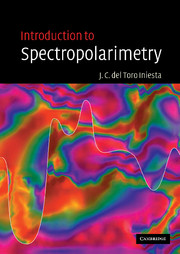Book contents
- Frontmatter
- Contents
- Preface
- Acknowledgements
- 1 Historical introduction
- 2 A review of some basic concepts
- 3 The polarization properties of quasi-monochromatic light
- 4 Linear optical systems acting on polarized light
- 5 Solar polarimetry
- 6 Absorption and dispersion
- 7 The radiative transfer equation
- 8 The RTE in the presence of a magnetic field
- 9 Solving the radiative transfer equation
- 10 Stokes spectrum diagnostics
- 11 Inversion of the RTE
- Index
1 - Historical introduction
Published online by Cambridge University Press: 11 August 2009
- Frontmatter
- Contents
- Preface
- Acknowledgements
- 1 Historical introduction
- 2 A review of some basic concepts
- 3 The polarization properties of quasi-monochromatic light
- 4 Linear optical systems acting on polarized light
- 5 Solar polarimetry
- 6 Absorption and dispersion
- 7 The radiative transfer equation
- 8 The RTE in the presence of a magnetic field
- 9 Solving the radiative transfer equation
- 10 Stokes spectrum diagnostics
- 11 Inversion of the RTE
- Index
Summary
Más has dicho, Sancho, de lo que sabes —dijo don Quijote—; que hay algunos que se cansan en saber y averiguar cosas que, después de sabidas y averiguadas, no importan un ardite al entendimiento ni a la memoria.
—M. de Cervantes Saavedra, 1615.‘You have said more than you realize,’ said Don Quijote, ‘for there are some, who exhaust themselves in learning and investigating things which, once known and verified, add not one jot to our understanding or our memory.’
Spectropolarimetry, as the name suggests, is the measurement of light that has been analyzed both spectroscopically and polarimetrically. In other words, both the wavelength distribution of energy and the vector properties of electromagnetic radiation are measured with the highest possible resolution and accuracy. Thus, spectropolarimetry embraces a number of techniques used in order to characterize light in the most exhaustive way. Such techniques are ultimately based on a theory that, from its beginnings in the closing years of the nineteenth century, finally grew to maturity in the 1990s. Therefore, under the heading of spectropolarimetry we will find several disciplines, which, despite being interrelated or rather, although our aim is to stress their interrelatedness, may be considered independent.
A historical perspective is always helpful for grasping the importance of physical phenomena and their corresponding explanations. The main objective of this chapter is to give a brief description of the salient events and findings in history related to some of the independent disciplines covered in this book.
- Type
- Chapter
- Information
- Introduction to Spectropolarimetry , pp. 1 - 8Publisher: Cambridge University PressPrint publication year: 2003



